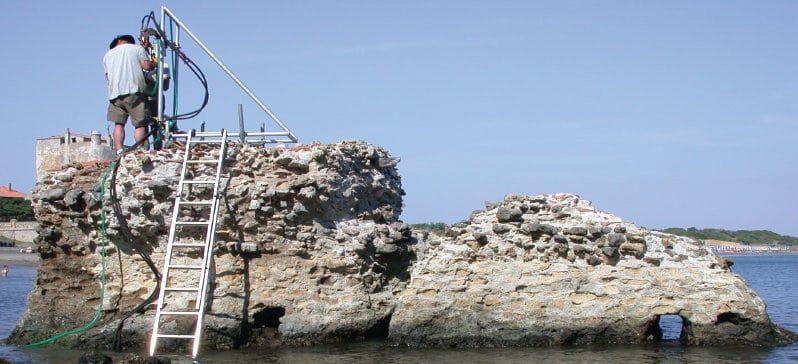
***EMBARGOED UNTIL 6PM BST, MON JULY 3RD (17.00 GMT)*** Samples from this Ancient Roman pier, Portus Cosanus in Orbetello, Italy, were studied with X-rays at Berkeley Lab. See National story NNCONCRETE; Ancient Roman buildings have survived thousands of years relatively intact because they made concrete from seawater, according to new research. And the study suggests the ancient recipe could help modern builders create structures to stand the test of time - while reducing global warming. The research shows that the iconic Colosseum, the Pantheon and Trajan's Markets survive today because ancient Romans made concrete out of seawater. An analysis of 2,000 year old cement made from volcanic ash and limestone suggests seawater was the secret ingredient.
Ancient Roman buildings have survived thousands of years relatively intact because they made concrete from seawater, according to new research.
And the study suggests the ancient recipe could help modern builders create structures to stand the test of time – while reducing global warming.
The research shows that the iconic Colosseum, the Pantheon and Trajan’s Markets survive today because ancient Romans made concrete out of seawater.
An analysis of 2,000 year old cement made from volcanic ash and limestone suggests seawater was the secret ingredient.
The work ultimately could lead to a wider adoption of concrete manufacturing techniques with less environmental impact than modern Portland cement manufacturing processes, which require high-temperature kilns.
These are a significant contributor to industrial carbon dioxide emissions, which add to the build-up of greenhouse gases in Earth’s atmosphere.
Professor Maria Jackson, a geologist at Utah University in the US, said: “Contrary to the principles of modern cement-based concrete the Romans created a rock-like concrete that thrives in open chemical exchange with seawater.”
Her team found seawater filtering leads to the growth of interlocking minerals that lend the concrete added cohesion.
The study, published in the journal American Mineralogist, says Romans made concrete by mixing volcanic ash with lime and seawater to make a mortar.
They then incorporated into that mortar chunks of volcanic rock – the ‘aggregate’ in the concrete.
The combination of ash, water and baked limestone or lime produces what is called a pozzolanic reaction – named after the city of Pozzuoli in the Bay of Naples.
The Romans may have got the idea for this mixture from naturally cemented volcanic ash deposits called tuff that are common in the area and were described by Roman author Pliny the Elder in his Naturalis Historia.
Most modern concrete is a mix of Portland cement – limestone, sandstone, ash, chalk, iron, and clay, among other ingredients, heated to form a glassy material that is finely ground – mixed with so-called “aggregates.”
These are materials such as sand or crushed stone that are not intended to chemically react. If reactions do occur in these aggregates, they can cause unwanted expansions in the concrete.
Prof Jackson has a simple explanation for why Roman concrete isn’t still used – despite its advantages.
She said: “The recipe was completely lost.”
She has extensively studied ancient Roman texts but hasn’t yet uncovered the precise methods for mixing the marine mortar, to fully recreate the concrete.
She said: “Romans were fortunate in the type of rock they had to work with. They observed volcanic ash grew cements to produce the tuff.
“We don’t have those rocks in a lot of the world, so there would have to be substitutions made.”
But she is now planning to develop a replacement recipe using materials from the west coast of the US.
The seawater in her experiments comes from a marina at Berkeley in California she has collected herself.
Roman concrete takes time to develop from seawater and features less compressive strength than typical Portland cement.
For those reasons it’s unlikely it could become widespread – but could be useful in particular contexts.
Her findings could be important for on a proposed lagoon to be built in Swansea to harness tidal power.
The lagoon, she says, would need to operate for 120 years to recoup the costs incurred to build it.
Prof Jackson said: “You can imagine that, with the way we build now, it would be a mass of corroding steel by that time.”
A Roman concrete prototype, on the other hand, could remain intact for centuries.
A reformulated recipe could also be tested for applications such as seawalls and other ocean-facing structures, and may be useful for safeguarding hazardous wastes.
Prof Jackson said: “The Romans were concerned with this. If we’re going to build in the sea, we should be concerned with it too.”
She led colleagues at California University in Berkely who used X-rays to study samples of Roman concrete – from an ancient pier at Portus Cosanus in Orbetello, Italy – at microscopic scales.
It followed earlier work by the same team which found crystals of aluminous tobermorite played a key role in strengthening the concrete as they grew in lime.